Next generation sequencing (NGS), high-throughput sequencing, or massively parallel sequencing are related terms that describe the DNA sequencing technology which has revolutionized the biological research. Characterized by ultra-high throughput, scalability, and speed, NGS enables researchers to sequence a human genome within a single day, which Sanger sequencing took over a decade to accomplish the final human genome draft.
What is NGS?
NGS represents a number of diverse modern high-throughput sequencing technologies, including Illumine sequencing, Roche 454 sequencing, and Ion Torrent sequencing. NGS leverage sequencing by synthesis (SBS) technology – detecting bases as they are incorporated into extended DNA strands – in a massively parallel fashion.
NGS platforms sequence numerous short reads in a single stroke. To do this, the input sample should first be cleaved into short reads. The lengths of these sections depend on the used sequencing instrument type and configuration.
- Illumina sequencing
Illumina entered the next-gen sequencing market after they acquired Solexa in late 2006. As the mostly adopted NGS instruments, Illumina technology leverages clonal array formation and reversible terminator technology for large-scale sequencing (Figure 1). Several samples can be simultaneously loaded onto the eight-lane flow cell (Figure 2). Fragments are first ligated to generic adaptors and are annealed. Solid-phase PCR amplification generates up to 1,000 copies of each template molecule. They are then separated into single strands for sequencing. During each cycle, fluorescently-labeled dNTPs (different colors is corresponding to different bases) are added to the nucleic acid chain. The nucleotide label serves as a terminator for polymerization, so an image is taken about the fluorescent dye after each dNTP incorporation. And then the enzymatic cleavage allows incorporation of next base.

Figure 1. The principle of Illumina sequencing (from the network).
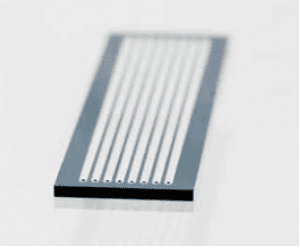
Figure 2. Eight-lane flow cell on an Illumina sequencing system (from the network).
Table 1. Illumina Specifications Table.
| iSeq | MiniSeq | MiSeq | NextSeq | |
|
Run Time |
9–17.5 hours | 4–24 hours | 4–55 hours | 12-30 hours |
|
Maximum Output |
1.2 Gb | 7.5 Gb | 15 Gb |
120 Gb |
| Maximum Reads Per Run | 4 million | 25 million | 25 million † |
400 million |
| Maximum Read Length | 2 × 150 bp | 2 × 150 bp | 2 × 300 bp |
2 × 150 bp |
- 454 sequencing
Roche 454 was the first commercial NGS platforms, which is launched in 2005. While Illumina uses 100-300 bp reads, Roche 454 can sequence longer reads (up to 1 Kb). The DNA is broken up into small fragments of 300-800 bp using restriction enzymes. Generic adaptors are added to the ends and then annealed to DNA sequences on tiny resin beads. The Roche 454 uses emulsion PCR, different from Illumina sequencing, to amplify DNA library. Each well will contain a single bead and many PCR copies of a single sequence, as well as DNA polymerase and buffers for sequencing. Nucleotide bases are added to the wells in waves of one type of base at a time, and the addition of each base releases a light signal, which is recorded by a camera.
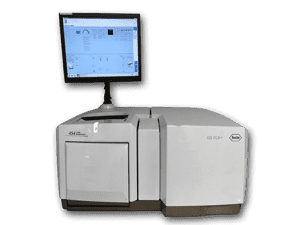 |
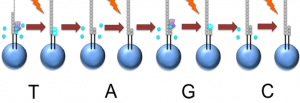 |
| Figure 3. Roche 454 platforms (from the network). |
Figure 4. The principle of Roche 454 sequencing (from the network). |
- Ion Torrent sequencing
ThermoFisher expanded their NGS portfolio after the acquisition of Ion Torrent. Their first NGS system, Ion PGM was launched in 2010. The input DNA or RNA for Ion Torrent sequencing is 200-600 bp. Like 454, Ion Torrent sequencing also uses emulsion PCR and adds a single species of dNTP at a time. But Ion torrent determines the incorporated bases based on the fact that the addition of a base releases an H+ ion.
Figure 5. The principle of Ion Torrent sequencing (from the network).
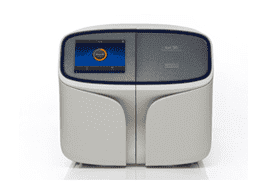 |
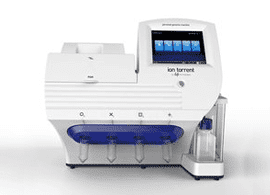 |
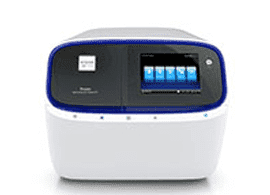 |
| Ion S5 Series systems | Ion PGM Sequencer |
Ion Proton System |
Figure 6. Ion Torrent sequencing platforms.
What can NGS do?
NGS technology allows researchers to deeply sequence target regions, rapidly sequence whole genomes, specifically sequence transcriptome to identify splice sites and RNA sites, identify epigenetic modifications, study microbial diversity and evolution, and sequence diseased samples to discover variants (which may be disease biomarkers or therapeutic targets). With the reducing price and increasing precision, NGS has become an indispensable tool in genomic research, and translated into routine clinical practice for precise medicine. The main limitation of NGS is the required infrastructure, including computer capacity and storage, and the personnel expertise that are required to analyze and interpret numerous data generated by NGS. Although challenged by the rapid development of third-generation sequencing technologies (including PacBio SMRT and Nanopore technologies), NGS has incomparable advantages and will not be completely replaced for quite a long time .
References:
Behjati S, Tarpey P S. What is next generation sequencing?. Archives of Disease in Childhood-Education and Practice, 2013, 98(6): 236-238.

Leave a Reply